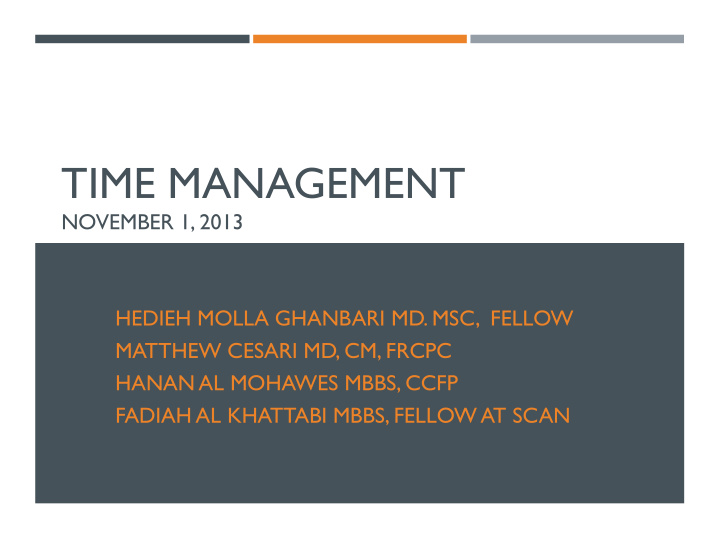



TIME MANAGEMENT NOVEMBER 1, 2013 HEDIEH MOLLA GHANBARI MD. MSC, FELLOW MATTHEW CESARI MD, CM, FRCPC HANAN AL MOHAWES MBBS, CCFP FADIAH AL KHATTABI MBBS, FELLOW AT SCAN
WHAT? To define time management To describe the general principles of time management Barriers to effective time management To apply time management principles to your academic schedule To relate time management principle to teaching To manage a rowdy classroom
HOW? Start Activity Durati time on (min) 8:00 Welcome + Ice Breaker 10 8:10 Pre-Test 5 8:15 Principles of Time Management 30 8:45 Family Feud(barriers to effective time management) 5 8:50 Barriers to effective time management Application: analysis of sample schedules 30 9:30 BREAK- refreshments 10:00 Clip of movie and critical analysis of Teaching and time 20 management 10:20 Tips for time management while teaching 25 10:45 Rowdy classroom and its management 30 11:15 Post test 5 11:20 Reflection and summary 10 11:30 Evaluations 30
WORK PLAN/ORGANIZATION Tasks Due dates Develop charter Nov 9, 2013 Literature review: - General references (H.A.) Nov 12, 2013 - Specific references ( M.C., H.G., F.A.) Nov 16, 2013 Meetings - Weekly for length 2 hours till Nov 22nd - Every other Saturday for length of 2 hours after Nov 22 nd Posting of outline (finalized via email) Nov 22, 2013 Divisions of workshop tasks - Principles of time management (Fadiah) - Barriers to effective time management (Hanan) - Tips for time management while teaching (Hedieh) - Rowdy classroom and its management (Matthew)
REFERENCES (1) student learning commons. Time Managment workshop. Available at: learningcommons.sfu.ca/file-newest/218/multi-time.pdf. Accessed October 31, 2013. (2) Time Management Behavior as a Moderator for the Job Demand- Control Interaction. Peeters, Miranda A. G.; Rutte, Christel G.Journal of Occupational Health Psychology, Vol 10(1), Jan 2005, 64-75. (3) Assude T. Time Managment in the Work Economy of a Class, a Case Study:Integration of Cabri in Primary School Mathematics Teaching. Beyond The Apparent Banality of the Mathematics Classroom: Springer; 2005. p. 183-203.
Recommend
More recommend